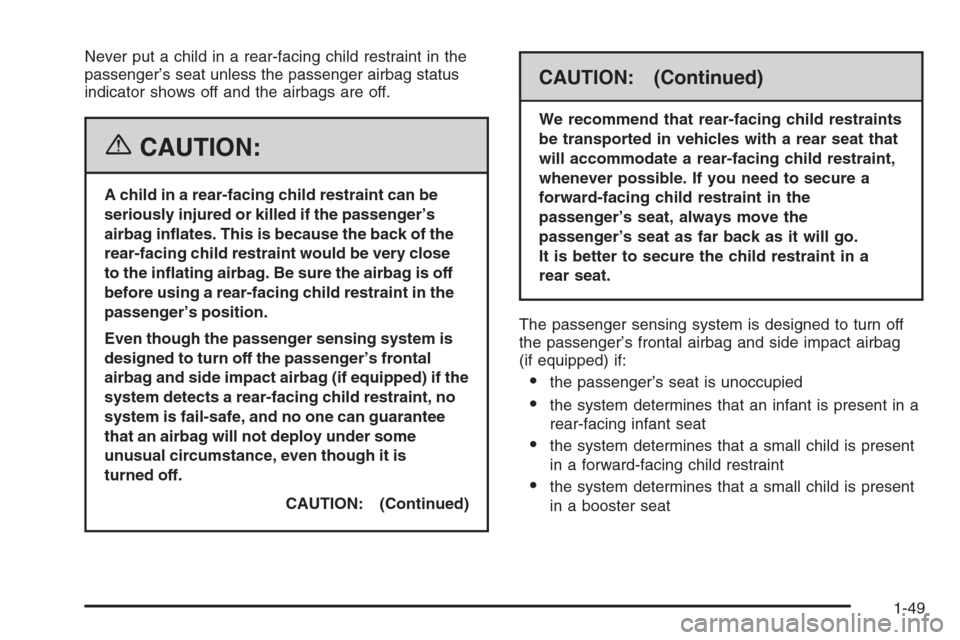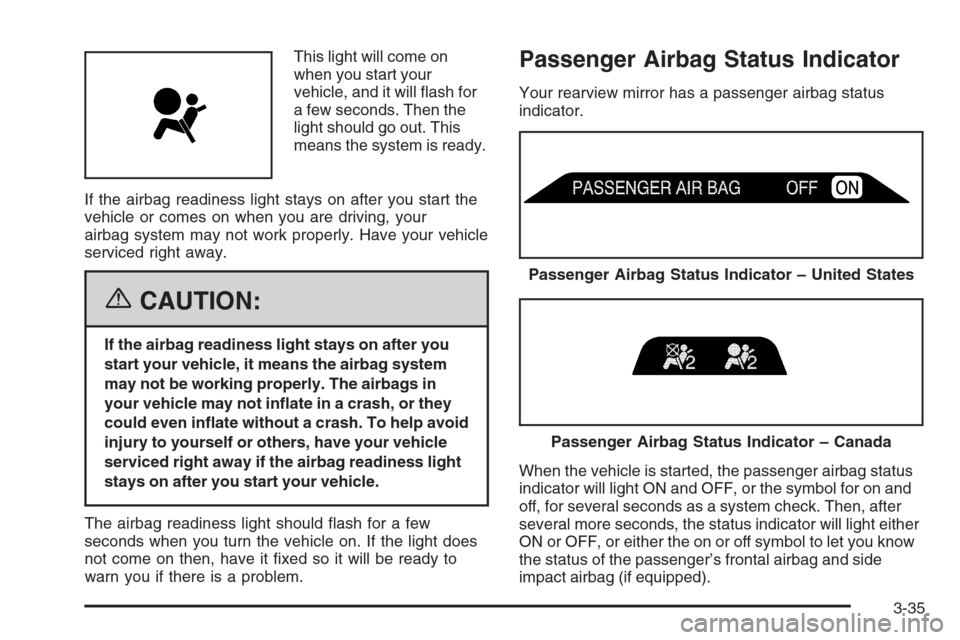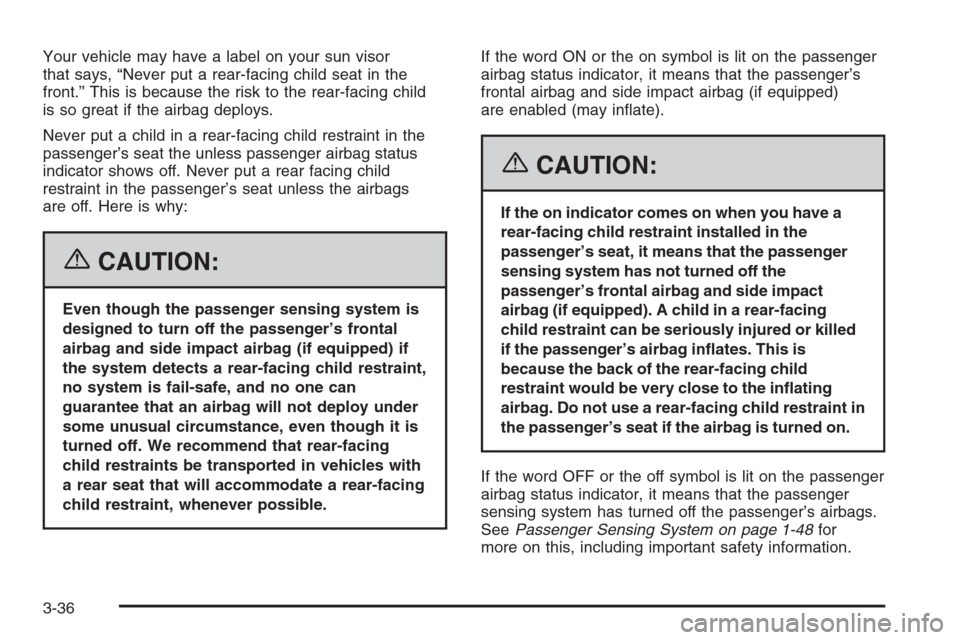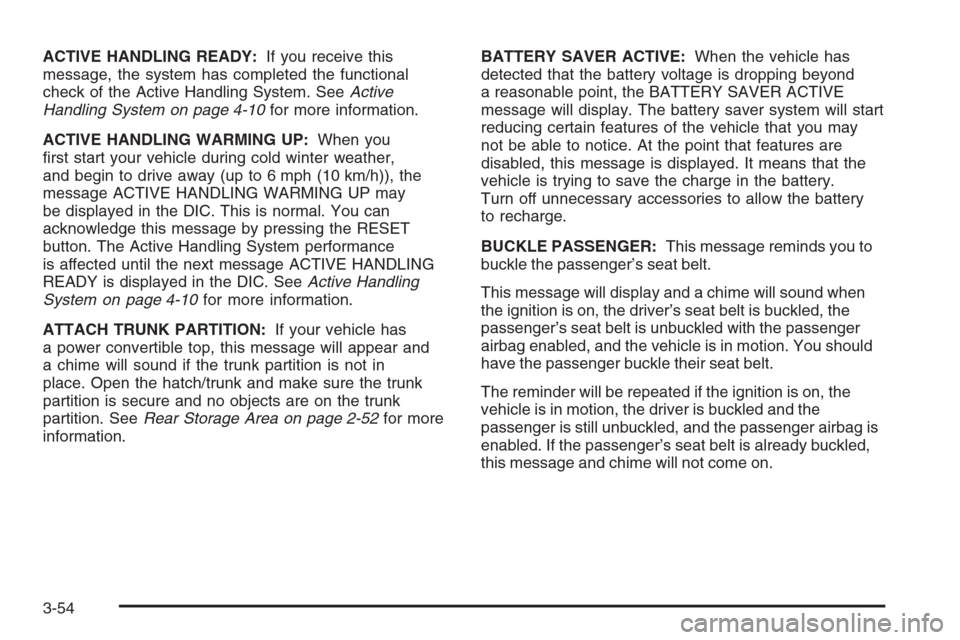2006 CHEVROLET CORVETTE airbag off
[x] Cancel search: airbag offPage 55 of 426

Never put a child in a rear-facing child restraint in the
passenger’s seat unless the passenger airbag status
indicator shows off and the airbags are off.
{CAUTION:
A child in a rear-facing child restraint can be
seriously injured or killed if the passenger’s
airbag in�ates. This is because the back of the
rear-facing child restraint would be very close
to the in�ating airbag. Be sure the airbag is off
before using a rear-facing child restraint in the
passenger’s position.
Even though the passenger sensing system is
designed to turn off the passenger’s frontal
airbag and side impact airbag (if equipped) if the
system detects a rear-facing child restraint, no
system is fail-safe, and no one can guarantee
that an airbag will not deploy under some
unusual circumstance, even though it is
turned off.
CAUTION: (Continued)
CAUTION: (Continued)
We recommend that rear-facing child restraints
be transported in vehicles with a rear seat that
will accommodate a rear-facing child restraint,
whenever possible. If you need to secure a
forward-facing child restraint in the
passenger’s seat, always move the
passenger’s seat as far back as it will go.
It is better to secure the child restraint in a
rear seat.
The passenger sensing system is designed to turn off
the passenger’s frontal airbag and side impact airbag
(if equipped) if:
the passenger’s seat is unoccupied
the system determines that an infant is present in a
rear-facing infant seat
the system determines that a small child is present
in a forward-facing child restraint
the system determines that a small child is present
in a booster seat
1-49
Page 56 of 426

a passenger takes his/her weight off of the seat for
a period of time
the passenger’s seat is occupied by a smaller
person, such as a child who has outgrown
child restraints
or if there is a critical problem with the airbag
system or the passenger sensing system
When the passenger’s frontal airbag and side impact
airbag (if equipped) have been turned off by the
passenger sensing system, the off indicator will light
and stay lit to remind you that the airbags are off.
If a child restraint has been installed and the on indicator
is lit, turn the vehicle off. Remove the child restraint
from the vehicle and reinstall the child restraint following
the child restraint manufacturer’s directions and refer
toSecuring a Child Restraint in the Passenger
Seat Position on page 1-35.
If after reinstalling the child restraint and restarting the
vehicle, the on indicator is still lit, check to make sure
that the vehicle’s seatback is not pressing the child
restraint into the seat cushion. If this happens, slightly
recline the vehicle’s seatback and adjust the seat
cushion if possible.
If the on indicator is still lit, do not secure the child
restraint in this vehicle and check with your dealer.The passenger sensing system is designed to enable
(may in�ate) the passenger’s frontal airbag and
side impact airbag (if equipped) anytime the system
senses that a person of adult size is sitting properly in
the passenger’s seat. When the passenger sensing
system has allowed the airbags to be enabled, the on
indicator will light and stay lit to remind you that the
airbags are active.
For some children who have outgrown child restraints
and for very small adults, the passenger sensing system
may or may not turn off the passenger’s frontal airbag
and side impact airbag (if equipped), depending upon
the person’s seating posture and body build. Everyone
in your vehicle who has outgrown child restraints should
wear a safety belt properly — whether or not there is an
airbag for that person.
If a person of adult-size is sitting in the passenger’s
seat, but the off indicator is lit, it could be because that
person is not sitting properly in the seat. If this happens,
turn the vehicle off and ask the person to place the
seatback in the fully upright position, then sit upright in
the seat, centered on the seat cushion, with the person’s
legs comfortably extended. Restart the vehicle and have
the person remain in this position for about two minutes.
This will allow the system to detect that person and then
enable the passenger’s frontal airbag and side impact
airbag (if equipped).
1-50
Page 58 of 426

Aftermarket equipment, such as seat covers, can affect
how well the passenger sensing system operates.
You may want to consider not using seat covers or other
aftermarket equipment if your vehicle has the passenger
sensing system. SeeAdding Equipment to Your
Airbag-Equipped Vehicle on page 1-53for more
information about modi�cations that can affect how the
system operates.
{CAUTION:
Stowing of articles under the passenger’s seat
or between the passenger’s seat cushion
and seatback may interfere with the proper
operation of the passenger sensing system.
Servicing Your Airbag-Equipped
Vehicle
Airbags affect how your vehicle should be serviced.
There are parts of the airbag system in several places
around your vehicle. You do not want the system to
in�ate while someone is working on your vehicle.
Your dealer and the service manual have information
about servicing your vehicle and the airbag system.
To purchase a service manual, seeService Publications
Ordering Information on page 7-14.
{CAUTION:
For up to 10 seconds after the ignition key is
turned off and the battery is disconnected, an
airbag can still in�ate during improper service.
You can be injured if you are close to an airbag
when it in�ates. Avoid yellow connectors. They
are probably part of the airbag system. Be sure
to follow proper service procedures, and make
sure the person performing work for you is
quali�ed to do so.
The airbag system does not need regular maintenance.
1-52
Page 170 of 426

Speedometer and Odometer
Your speedometer lets you see your speed in either
miles per hour (mph) or kilometers per hour (km/h).
For more information see “Personal Options” under
DIC Vehicle Personalization on page 3-68.
To read the odometer with the ignition off, turn on the
parking lamps.
You may wonder what happens if your vehicle needs a
new odometer installed. The mileage total of the new
odometer will be set to the original miles (kilometers) of
the old odometer. See your dealer if the odometer must
be replaced in your vehicle.
Tachometer
The tachometer displays the engine speed in thousands
of revolutions per minute (rpm).
Notice:Fuel will shut off at about 6600 rpm for the
base model and 7100 rpm for the Z06 model. If you
continue to drive your vehicle at the fuel shut off rpm,
you could damage your engine. Be sure to operate
your vehicle below the fuel shut off rpm or reduce
your rpm quickly when the fuel shuts off.
Safety Belt Reminder Light
When the ignition is turned on, a chime will be provided
for several seconds to remind people to buckle their
safety belts. The driver safety belt light will also be
provided and stay on for several seconds, then it will
�ash for several more. You should buckle your seat belt.
If the driver’s belt is
buckled, neither the
chime nor the light will
be provided.
Airbag Readiness Light
There is an airbag readiness light on the instrument
panel, which shows a deployed airbag symbol.
The system checks the airbag’s electrical system for
malfunctions. The light tells you if there is an electrical
problem. The system check includes the airbag
modules, the wiring and the diagnostic module.
For more information on the airbag system, seeAirbag
System on page 1-40.
3-34
Page 171 of 426

This light will come on
when you start your
vehicle, and it will �ash for
a few seconds. Then the
light should go out. This
means the system is ready.
If the airbag readiness light stays on after you start the
vehicle or comes on when you are driving, your
airbag system may not work properly. Have your vehicle
serviced right away.
{CAUTION:
If the airbag readiness light stays on after you
start your vehicle, it means the airbag system
may not be working properly. The airbags in
your vehicle may not in�ate in a crash, or they
could even in�ate without a crash. To help avoid
injury to yourself or others, have your vehicle
serviced right away if the airbag readiness light
stays on after you start your vehicle.
The airbag readiness light should �ash for a few
seconds when you turn the vehicle on. If the light does
not come on then, have it �xed so it will be ready to
warn you if there is a problem.
Passenger Airbag Status Indicator
Your rearview mirror has a passenger airbag status
indicator.
When the vehicle is started, the passenger airbag status
indicator will light ON and OFF, or the symbol for on and
off, for several seconds as a system check. Then, after
several more seconds, the status indicator will light either
ON or OFF, or either the on or off symbol to let you know
the status of the passenger’s frontal airbag and side
impact airbag (if equipped).
Passenger Airbag Status Indicator – United States
Passenger Airbag Status Indicator – Canada
3-35
Page 172 of 426

Your vehicle may have a label on your sun visor
that says, “Never put a rear-facing child seat in the
front.” This is because the risk to the rear-facing child
is so great if the airbag deploys.
Never put a child in a rear-facing child restraint in the
passenger’s seat the unless passenger airbag status
indicator shows off. Never put a rear facing child
restraint in the passenger’s seat unless the airbags
are off. Here is why:
{CAUTION:
Even though the passenger sensing system is
designed to turn off the passenger’s frontal
airbag and side impact airbag (if equipped) if
the system detects a rear-facing child restraint,
no system is fail-safe, and no one can
guarantee that an airbag will not deploy under
some unusual circumstance, even though it is
turned off. We recommend that rear-facing
child restraints be transported in vehicles with
a rear seat that will accommodate a rear-facing
child restraint, whenever possible.If the word ON or the on symbol is lit on the passenger
airbag status indicator, it means that the passenger’s
frontal airbag and side impact airbag (if equipped)
are enabled (may in�ate).
{CAUTION:
If the on indicator comes on when you have a
rear-facing child restraint installed in the
passenger’s seat, it means that the passenger
sensing system has not turned off the
passenger’s frontal airbag and side impact
airbag (if equipped). A child in a rear-facing
child restraint can be seriously injured or killed
if the passenger’s airbag in�ates. This is
because the back of the rear-facing child
restraint would be very close to the in�ating
airbag. Do not use a rear-facing child restraint in
the passenger’s seat if the airbag is turned on.
If the word OFF or the off symbol is lit on the passenger
airbag status indicator, it means that the passenger
sensing system has turned off the passenger’s airbags.
SeePassenger Sensing System on page 1-48for
more on this, including important safety information.
3-36
Page 173 of 426

If, after several seconds, all status indicator lights
remain on, or if there are no lights at all, there may be
a problem with the lights or the passenger sensing
system. See your dealer for service.
{CAUTION:
If the airbag off indicator and the airbag
readiness light ever come on together, it means
that something may be wrong with the airbag
system. If this ever happens, have the vehicle
serviced promptly, because an adult-size
person sitting in the right front passenger seat
may not have the protection of the airbag. See
Airbag Readiness Light on page 3-34.
Voltmeter Gage
The voltmeter shows the
voltage output of your
battery. When the engine
is running, it shows
the voltage output of the
charging system.
The reading will change as the rate of charge changes
(with engine speed, for example), but if the voltmeter
reads at 9 volts or below, your instrument panel
cluster and other systems may shut down. The Driver
Information Center (DIC) will read BATTERY VOLTAGE
LOW when your vehicle is at 10 volts or below. Have
it checked right away. Driving with the voltmeter reading
at 10 volts or below could drain your battery and
disable your vehicle.
3-37
Page 190 of 426

ACTIVE HANDLING READY:If you receive this
message, the system has completed the functional
check of the Active Handling System. SeeActive
Handling System on page 4-10for more information.
ACTIVE HANDLING WARMING UP:When you
�rst start your vehicle during cold winter weather,
and begin to drive away (up to 6 mph (10 km/h)), the
message ACTIVE HANDLING WARMING UP may
be displayed in the DIC. This is normal. You can
acknowledge this message by pressing the RESET
button. The Active Handling System performance
is affected until the next message ACTIVE HANDLING
READY is displayed in the DIC. SeeActive Handling
System on page 4-10for more information.
ATTACH TRUNK PARTITION:If your vehicle has
a power convertible top, this message will appear and
a chime will sound if the trunk partition is not in
place. Open the hatch/trunk and make sure the trunk
partition is secure and no objects are on the trunk
partition. SeeRear Storage Area on page 2-52for more
information.BATTERY SAVER ACTIVE:When the vehicle has
detected that the battery voltage is dropping beyond
a reasonable point, the BATTERY SAVER ACTIVE
message will display. The battery saver system will start
reducing certain features of the vehicle that you may
not be able to notice. At the point that features are
disabled, this message is displayed. It means that the
vehicle is trying to save the charge in the battery.
Turn off unnecessary accessories to allow the battery
to recharge.
BUCKLE PASSENGER:This message reminds you to
buckle the passenger’s seat belt.
This message will display and a chime will sound when
the ignition is on, the driver’s seat belt is buckled, the
passenger’s seat belt is unbuckled with the passenger
airbag enabled, and the vehicle is in motion. You should
have the passenger buckle their seat belt.
The reminder will be repeated if the ignition is on, the
vehicle is in motion, the driver is buckled and the
passenger is still unbuckled, and the passenger airbag is
enabled. If the passenger’s seat belt is already buckled,
this message and chime will not come on.
3-54